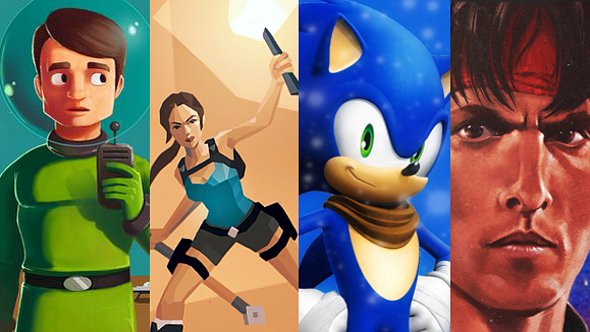With 2015 finally put out to pasture, it’s time once again — as is our yearly tradition at iFanzine — to look back and decide what exactly were the top ten games released last year. As always I’d like to remind everyone that only games I’ve personally played can qualify for this list, so as to ensure that I am personally vouching for the quality of every last entry (rather than merely bowing to the hype). Secondly, they also need to have either released in 2015 — or at the very least received major content revisions during that time frame — or else this would quickly end up becoming a “Top Ten Best of All Time” list.
As a result — as much I might prefer otherwise — I won’t be able to feature the amazing Fairune (our review), an utterly-free high-quality old-school top-down Action-RPG that is furthermore being offered for absolutely nothing at all (and sadly released in 2013). We furthermore won’t be listing Toby Fox’s phenomenally amazing Undertale because, although technically meeting all of the previously listed requirements, it’s not actually available on iOS. That said — assuming you have a PC — you really do owe it to yourself to check Undertale out, as there are very good reasons this Bullet-Hell RPG exploded to super-stardom levels of popularity within just a few months’ span of time.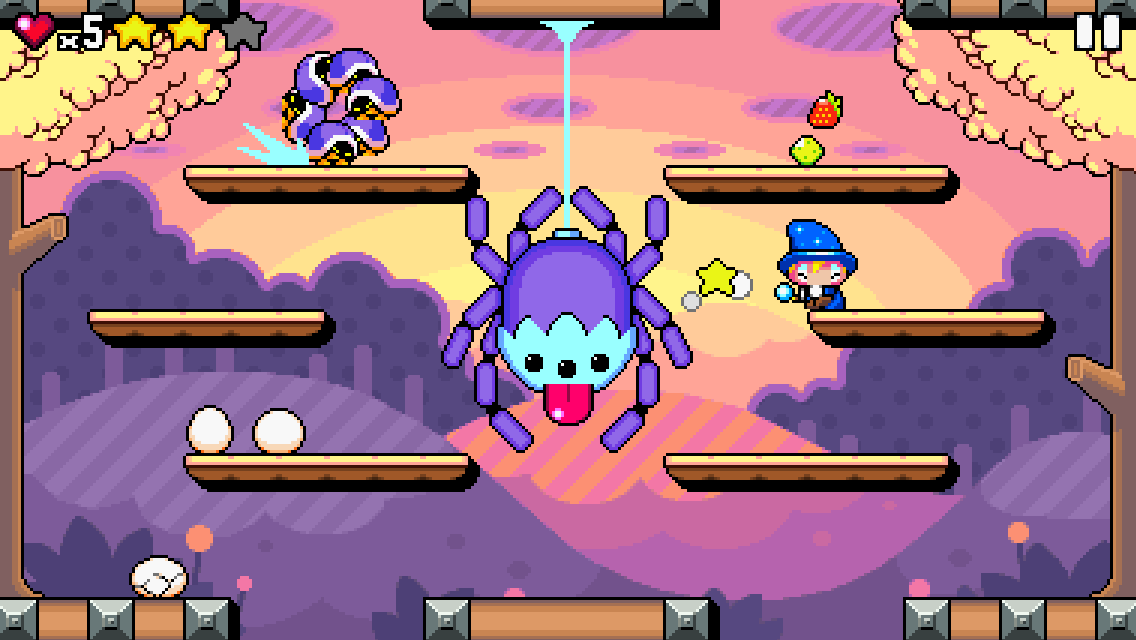
Drop Wizard
Neutronized’s Drop Wizard (our review) does a resplendent job of feeling as though it were a legitimate spiritual successor to Taito’s esteemed Bubble Bobble and Rainbow Islands. The game features a seemingly simple combat system, wherein your mage — whom you may order to walk either left or right, but never stand still — will fire enemy-stunning stars whenever he drops down a ledge. After an enemy has been stunned you can then kick them if you quickly touch them before they wake up, and they’ll then knock out any other enemies — whether they’re stunned or not — that they roll into.
This might seem simple at first, but — much like the Taito classics that Drop Wizard is aspiring to — things will quickly go from “simple and easy” to “puzzling and downright maddening”. Of course — as it wouldn’t be a proper tribute otherwise — there’s also massive scoring potential for those whom truly master the mechanics, in the process learning how to sometimes clear entire stages just by kicking a single stunned-enemy. Truly — if you’re someone seeking a game paying homage to the arcade classics of the early eighties — then you can’t possibly go wrong with Drop Wizard, which is worth every last cent of the asking price.
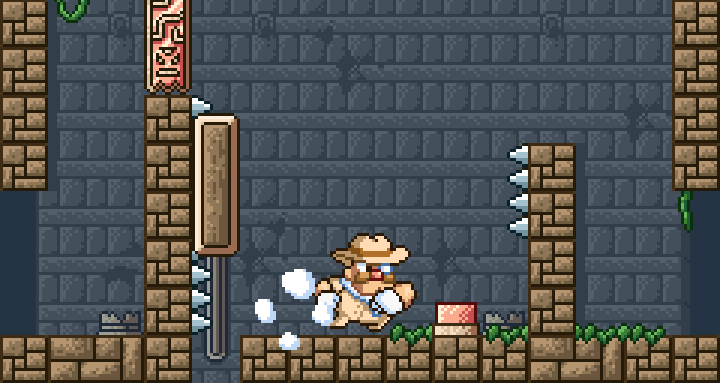
Duke Dashington
Sometimes mobile games seem to be designed in ways which somehow forget that people most often use such devices when they’re on the go, rather than sitting within the comfort of their own home. Duke Dashington (our review) — however — bucks this trend with the boldest of statements possible: each level must be finished within just ten seconds, and yet that doesn’t mean you should be expecting some easy-peasy challenges. Either by swiping, or via on screen buttons, you can order the intrepid explorer to jump and dash about; although he can only jump while touching the ground — he may dash even when otherwise midair — and Duke only stops after slamming himself into a solid wall.
The variety of challenges and situations created with this simple setup are absolutely staggering, but thankfully your progress is saved after each and every ten-second room you triumphantly overcome (and expect most failures to be from traps, not the timer). Perhaps the greatest compliment I can give to the colossally-involving ten-second challenges found withinDuke Dashington is that, even when you’re doing them correctly, they often feel as though far more than just ten seconds have passed. When a game has successfully made you so aware of every last micro-second — yet is still fun as well — you know something amazing has been achieved, all thanks to Jussi Simpanen.
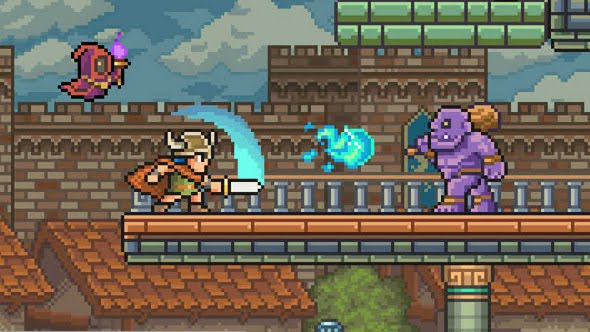 Goblin Sword
Goblin Sword
There’s a good reason that Eleftherios Christodoulatos’s tale of swashbuckling quickly excited so many iDevice owners, and that’s because Goblin Sword (our review) is an excellent tribute to 16-bit era side-scrolling platform-jumping hack-and-slash adventures! The game currently features a whopping 80 sprawling-levels for players to double-jump and slash their way through, all while trying to track down all of the hidden gems and treasure chests. Although many iOS games allow players to in-game purchase various upgrades, one nice feature ofGoblin Sword is that the appearance of your character is directly influenced by whichever weapon and (purely cosmetic) outfit you have equipped.
Thankfully the app features extremely responsive touch-screen controls, as you’ll sometimes — should you delve into the game’s hidden levels — experience challenges nearly worthy of I Wanna Be The Guy (except without the traps coming out of nowhere). Now while the bulk of Goblin Sword’s eighty levels aren’t nearly that hard to deal with, I’d be lying if I didn’t admit that this game quickly goes from seemingly easy to rather brutal. The end result of all this is that Goblin Sword is a game featuring the kind of challenge necessary to please even long-time veterans of plaforming based action, yet — so long as you avoid the hidden stages — not truly unwelcome to newcomers either.
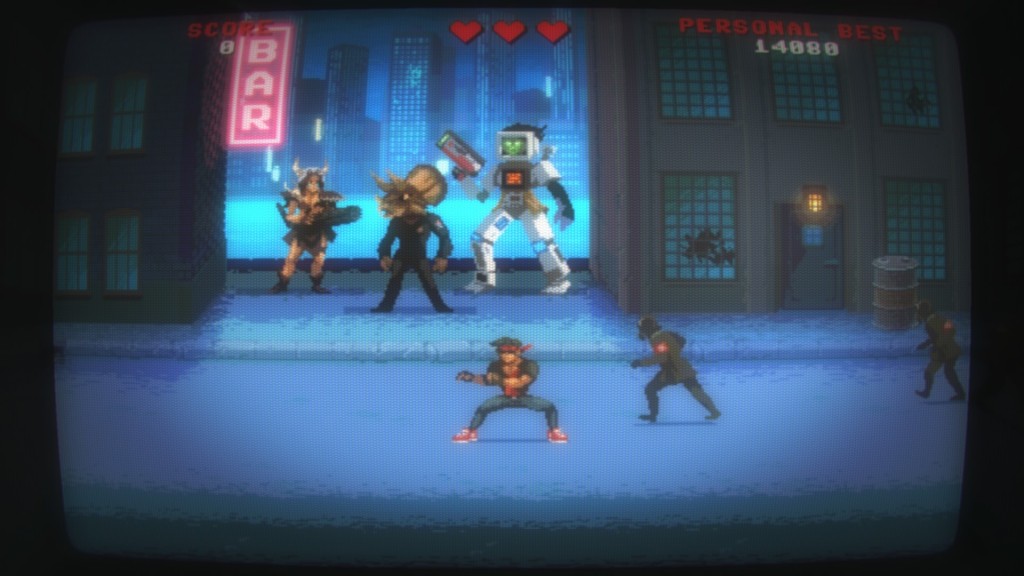
Kung Fury
The tie-in game to David Sandberg’s totally awesome 80’s action-film homage — Kung Fury: Street Rage – The Arcade Strikes Back (our review) — may well have one of the longest titles we’ve ever dealt with over here at iFanzine. In the game you take control of either the titular Kung Fury — or any of his amazing friends — as they do everything in their power to conquer the Nazi-filled armies of Adolf Hitler (AKA: the Kung Fuhrer). This is executed via a play-style very reminiscent of One Finger Death Punch, wherein players tap the side of the screen they wish to attack next (and although this might initially sound rather easy, you’ll discover that it quickly becomes super-challenging).
Players can engage in this fighting either via Kung Fury’s Endless Mode — wherein they strive to obtain the highest Nazi-punching score possible — or through the recently added Story Mode, which even includes fully-voiced performances by the actual film’s cast. Additionally, since David’s Kung Fury was supposed to the greatest forgotten 80’s movie that never was (complete with fake VHS tracking), Kung Fury: Street Rage also goes to impressive lengths in an attempt to convince you it’s genuinely that ancient as well. While games featuring retro-graphics aren’t exactly a novelty these days, when was the last time you saw one that also featured screen curvature — signal degradation — as well as top-notch renderings of various other problems that commonly plagued NTSC monitors?
Although Kung Fury: Street Rage’s developers have sadly apologized that not enough Nazis were harmed during the making of their absolutely free game, perhaps you can finally be the one to rectify that heinous oversight.
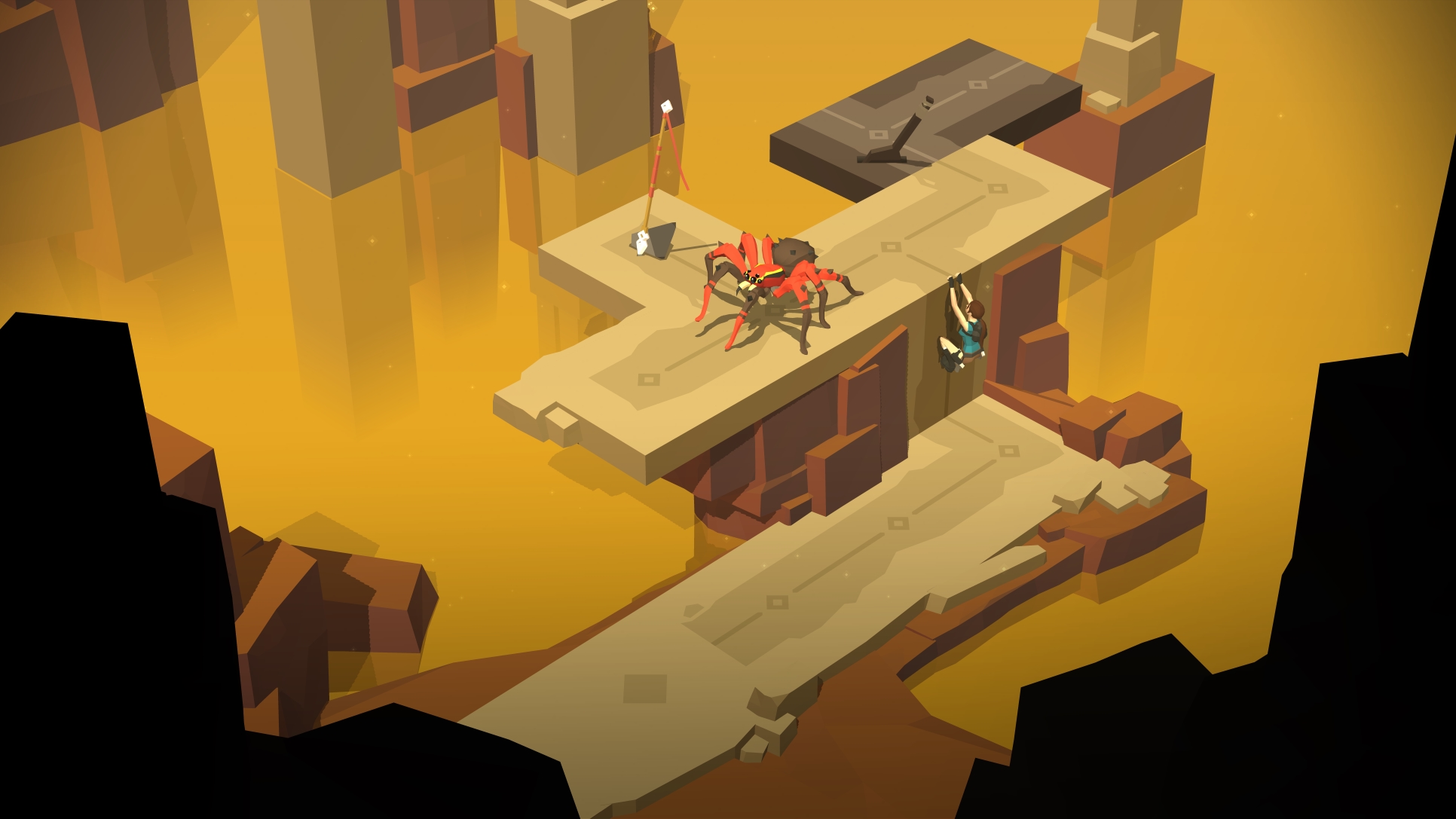
Lara Croft GO
The quality of Eidos’s Tomb Raider franchise definitely took a dramatic turn for the better after they were acquired by Square-Enix, and this trend — judging from the recent release of Lara Croft GO! (our review) — doesn’t appear to be slowing down even a little. In this game you take control of the titular heroine as she explores the isometric “Temple of the Giant Angry Snake” (so maybe that’s not actually its name, but this is what I think it should be called). The game itself is turn based — with players moving Lara one space at a time, or sometimes performing an action, after which all traps and monsters will take their turn — and this quickly proves to be quite a diabolically engaging puzzle-challenge!
Still — despite presenting players with some truly grand clockwork-style puzzles — Lara Croft GO!’s puzzles never devolve into purely unfair territory, making the odd-looking $4.99 “unlock all-stages” IAP-option far more innocuous than it might otherwise appear. What might interest players — however — is a purchasable package of alternative outfits that permit Lara to dress up like various classical Eidos icons, although many other unlockable outfits also exist that must be exclusively unlocked in-game. This is done by players tapping on pots — some of which are masterfully hidden — to find all of the secret gems and artifact-bits in each stage, as it wouldn’t really be a proper adventure otherwise.
Although not necessarily the cheapest puzzle game available on the iOS marketplace right now, you really should check out Lara Croft’s latest archeological outing (at least so long as you otherwise proclaim to value high-quality turn-based puzzle-experiences).
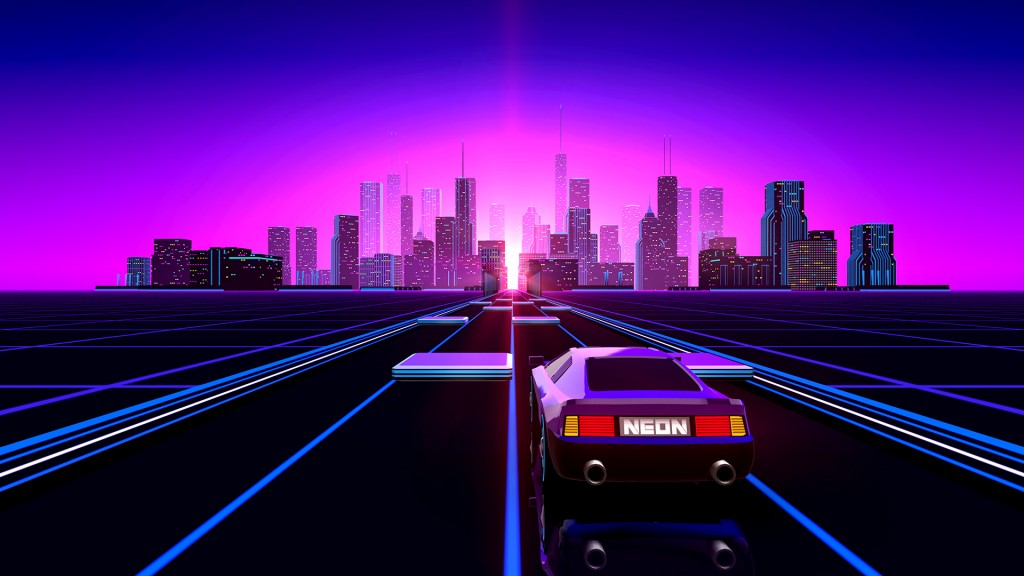
Neon Drive
Prepare to blast-off into an 80’s-inspired neon-infused vision of the future, the likes of which could perhaps only truly be realized with modern technology, in the recently debuted Neon Drive (our review)! Although the game play may initially seem simplistic, with players merely being asked to dodge left/right across lanes in order to avoid obstacles, one can’t just rule out how mesmerizing these stylized visuals truly are. There’s also the fact that Neon Drive may well be one of the most diabolically challenging games of rapid-fire precision dodging you’ve ever seen, even if the levels themselves aren’t randomized at all (or perhaps they’re all the harder because of that).
Oh, and did I mention that all of the game’s levels — with five currently available, and more coming in the future — have furthermore been synchronized to an appropriately synth-laden soundtrack? It’s hard to properly explain the feeling you get when — after properly mastering a stage — the game begins to feel as if the music is reacting to your driving, even if it’s actually the otherwise way around. Finally — and perhaps the ultimate icing on the cake — is that the entire package is being offered for absolutely free, all while utilizing an ad-based model to support the developer (rather than aggressive IAPs).
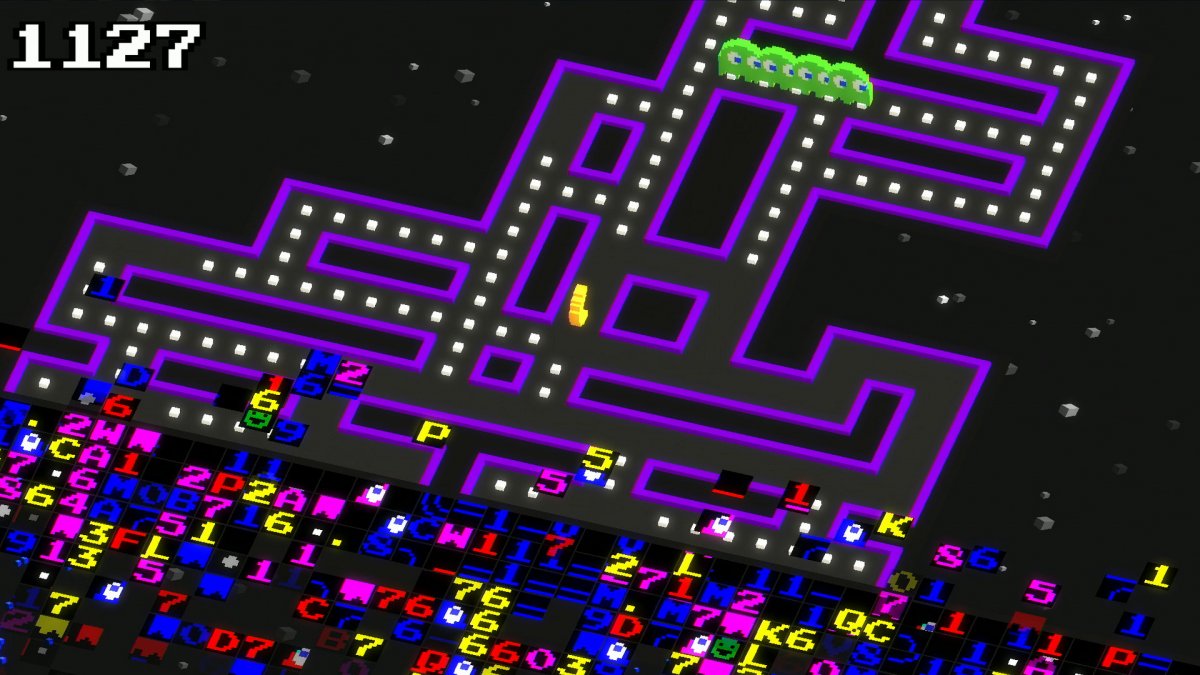
Pac-Man 256
Pop-Quiz Time: what do you get when you combine Namco Bandai’s most beloved pizza-shaped gaming icon with the extreme game-making talent found over at Hipster Whale? The answer — of course — is Pac-Man 256 (our review), a game that challenges Pac-Man to outrun his greatest villain ever: the corrupted data found on level 256’s infamous kill screen. Much like Hipster Whale’s Crossy Road (our review) was a brilliant endless-runner version of Frogger, Pac-Man 256 is a brilliant endless-runner spin on the classic top-down maze-based game play of Pac-Man (as opposed to Pac-Man Dash).
The game features you running endlessly upwards through a randomly-generated maze, doing whatever it takes to stay one step ahead of the unyielding corruption that is constantly creeping forward. Further complicating matters is that the various ghosts hanging about could care less about the ensuing apocalypse, meaning you’ll either need to dodge them — based on their specific behavior patterns — or otherwise take them out. While Pac-Man 256 may not feature the massive array of unlockable characters that Crossy Road has, you can — over the course of the game — gain access to additional power-up types appearing throughout the maze (such as laser-beams, flame-trails, and more).
If you ever previously enjoyed Satoru Iwatani’s original Pac-Man, Hipster Whale’s Crossy Road — or, better yet, both — then you positively owe it to yourself to immediately rush out and snatch up Pac-Man 256 (a freemium game with largely uninvasive IAPs).
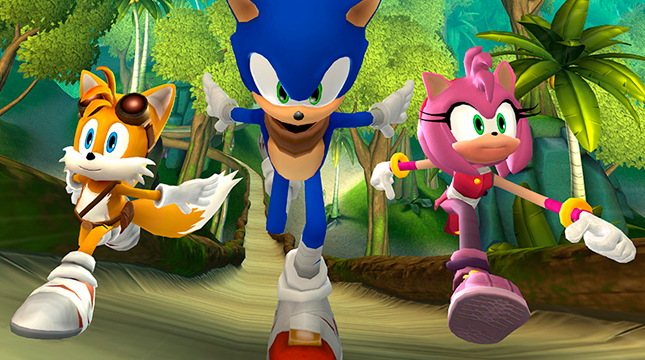
Sonic Dash 2
While most longtime readers of iFanzine would probably be rather well aware of just how much we adored the original Sonic Dash (our review), it would be admittedly unfair to claim that others didn’t have some real bones to pick with Hardlight Studios’ efforts. Thankfully pretty much all of that criticism — such as players being discouraged from ever using the speed-dash, or others being disgusted when the available missions-based challenges ran forever dry — has been addressed in exquisitely fine form this time around. Couple this with a rework of the ring-banking system — where players are no longer forced to choose between banking or high-scoring sections, but rather how to best use their chain-banking combo bonuses — and the original game play is quite improved here!
However — not content to merely tweak up various aspects of their original — Hardlight Studios has now added special abilities to each character on your roster, and you’ll even have the power to bring along any three of them at once (swappable whenever banking)! The only real downside one could really levy against the massively improved Sonic Dash 2 (our review) would be that it currently has far less content than the original does, but not necessarily so if you compare both games in their initial-launch conditions. Thankfully — however — this will almost assuredly be rectified with the passage of time, seeing as how both additional stages and characters have already been added within the scant few months since the app’s release.
Finally — while some of you might be upset that this game features the same designs as the infamous Sonic Boom: Rise of Lyric — I am personally assuring you all that’s not a very good reason to hold off on this; after all, Big Red Button wasn’t involved this time.
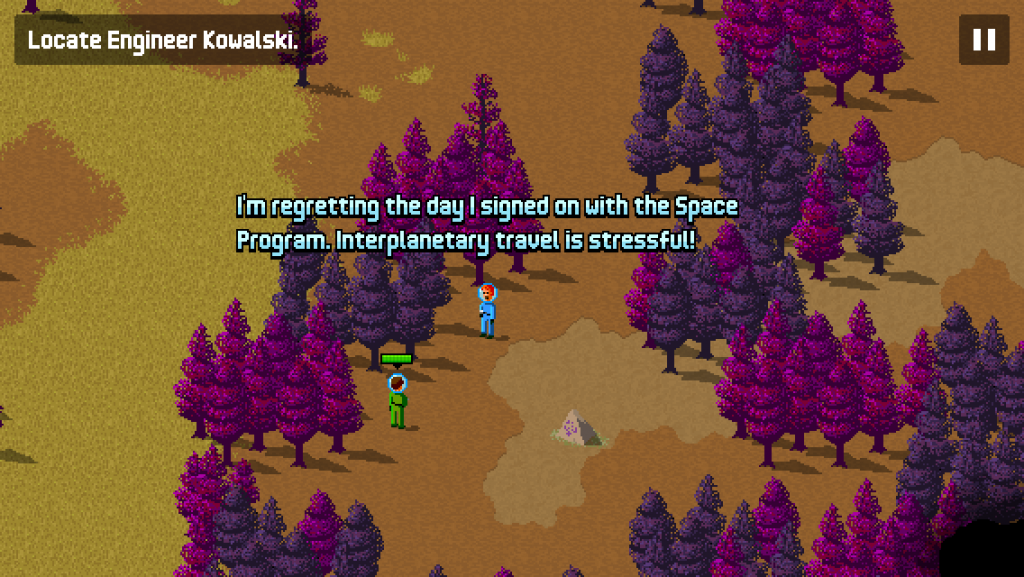
Space Age
Big Bucket Software’s Space Age (our review) — a game that combines RTS controls, Graphic Adventure style puzzles, Metal Gear Solid inspired espionage, alongside cheesy 50’s Sci-Fi logic campiness — is a product whose whole is admittedly more than sum of its parts. The game stars an unnamed private — aboard the Proteus-Z — as the ship’s crew explores the presumably uninhabited planet of Kepler-16*, their mission being to collect samples of the planet’s valuable Nucleum Ore. It’s a tale — set in the far off future of 1976 — that’s filled to the brim with straight-faced scientific improbabilities, fishbowl style helmets, phaser guns, engineers named Kowalski, and the consequences of decades old mistakes!
* (By the way, you can tell that Kepler-16 is obviously a fantastical alien world because the planet — which otherwise looks like a perfectly normal pine tree forest set on Earth — has trees that are shockingly purple.)
Rather than being sardonically dismissive of the material that builds the core of Space Age’s plot, the game instead treats this campy-material material with the same wide-eyed optimism that the 50’s did. As the game’s plot is a central component of Space Age’s appeal, Big Bucket’s app admittedly might not be for those whom don’t get excited about a tale containing everything right down to a stand-in for Robby the Robot. My only real complaint with the plot is not the content contained within, but rather the voicelessly-delivered on-screen text that auto-advances itself (although this usually isn’t a problem in and of itself, it could lead to a level-restart if you ever stumble while reading).
The game play is — sadly — plagued by more than a few issues likely to frustrate many players: characters walk around slowly, the controls are imprecise, the timing on stealth segments can be pixel-perfect, and some of the levels are rather long for mobile-gaming. Still, those who can over-look these individual faults — and instead enjoy the game as a collective whole — will largely enjoy their time spent with Big Bucket Software’s Space Age. Just make sure that you stick around for the credits — preferably with the volume turned up — for a very special scene that you genuinely wouldn’t want to miss, that I furthermore won’t be spoiling here.
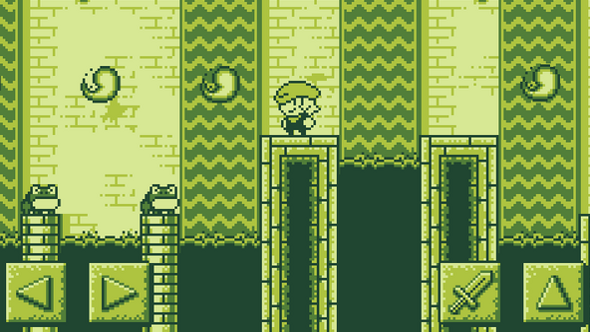
Tiny Dangerous Dungeons
It’s a truly rare honor for someone’s efforts to be appearing twice on the same year’s top-ten list, but Jussi Simpanen has managed to accomplish that exactly with Tiny Dangerous Dungeons (our review)! The game does a remarkable job of recreating the experience of playing a Metroidvania-style game on the Gameboy, both in terms of visual-presentation and mechanical-limitations (although there’s no motion-blur simulation going on here). You’ll initially begin this adventure with only the ability to walk and jump about, but you’ll quickly expand your repertoire by tracking down the dungeon’s various prizes (each of which will enable you to perform extra actions, as well as reach new locations).
Perhaps the only downside to all of this is that the entire package — much like many classical side-scrolling Gameboy adventures — can easily be finished within under thirty minutes, at least if you know what you’re doing (you get a time-trial option on replays). Don’t expect that you actually will finish this adventure that quickly the first time around — however — as you’ll first have to figure out how to solve all of the puzzles, and furthermore do so without dying. Which is to say nothing of the game’s four ultra-hidden secret rooms, all of which will require not only extremely good observational skills — but also displays of top-notch jumping prowess — in order to be both reached and plundered.
Although perhaps lacking the sophisticated screen-simulation effects employed by Super Win the Game, or even Kung Fury: Street Rage, Jussi Simpanen’s Tiny Dangerous Dungeons is sure to appeal to fans of retro-styled Metroidvania-type adventures.


